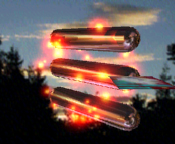A Hardware Rasterization Architecture for
Mobile Phones
Ericsson Research
ACM Transactions on Graphics, vol. 22, no. 3,
Proceedings of ACM SIGGRAPH 2003, pp. 801-808, July 2003.

Trilinear mipmapping, 1 sample/pixel. About 50% more expensive in bandwidth than the image to the right.

Rendered using inexpensive texture filtering & texture compression, Zmin-culling and with our FLIPQUAD multisampling.
Abstract
The mobile phone is one of the most widespread devices with rendering
capabilities. Those capabilities have been very limited because
the resources on such devices are extremely scarce; small
amounts of memory, little bandwidth, little chip area dedicated for
special purposes, and limited power consumption. The small display
resolutions present a further challenge; the angle subtended
by a pixel is relatively large, and therefore reasonably high quality
rendering is needed to generate high fidelity images.
To increase the mobile rendering capabilities, we propose a new
hardware architecture for rasterizing textured triangles. Our architecture
focuses on saving memory bandwidth, since an external
memory access typically is one of the most energy-consuming
operations, and because mobile phones need to use as little power
as possible. Therefore, our system includes three new key innovations:
I) an inexpensive multisampling scheme that gives relatively
high quality at the same cost of previous inexpensive schemes, II) a
texture minification system, including texture compression, which
gives quality relatively close to trilinear mipmapping at the cost
of 1.33 32-bit memory accesses on average, III) a scanline-based
culling scheme that avoids a significant amount of z-buffer reads,
and that only requires one context. Software simulations show that
these three innovations together significantly reduce the memory
bandwidth, and thus also the power consumption.
Paper and presentation:
Download pdf
Our presentation slides (26 MB)
Download movie clip (246 MB)
We presented our fastforward (50 seconds) at SIGGRAPH on a Sony Ericsson T610 mobile phone (click):


Misc material:
Our work has been mentioned in EE Times.
Note:
Since we got our paper accepted at SIGGRAPH, the average eye-to-pixel angle for
a mobile phone compared to a laptop/desktop seem to have changed from 2-4 times to
1-4 times. Also, we incorrectly state that the MBX architecture is a scaled-down version
of the Kyro architecture. We are sorry for this. [This was kindly pointed out by Simon Fenney
at Imagination Technologies]